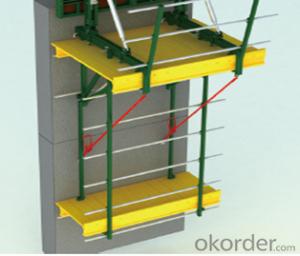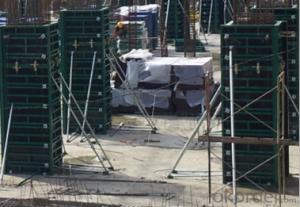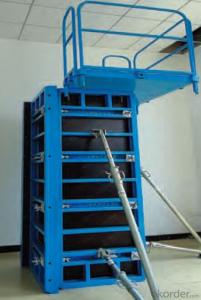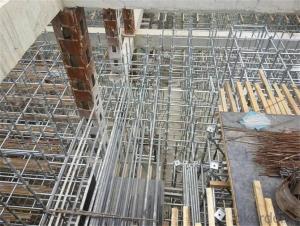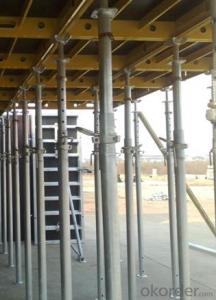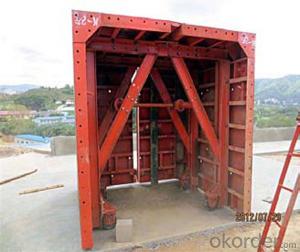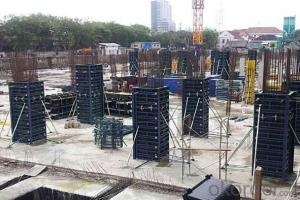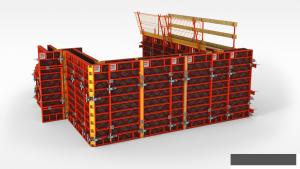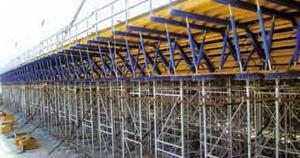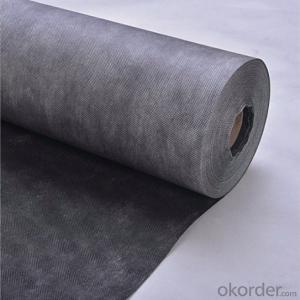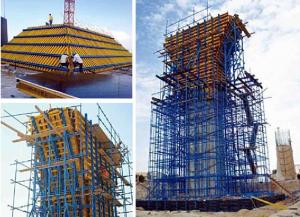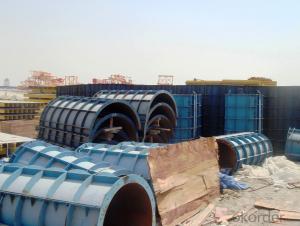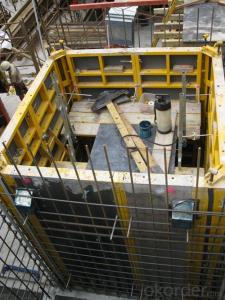STEEL FRAMED FORMWORK AND ITS ACCESSORIES FOR BUILDING CONSTRUCTION
- Loading Port:
- Shanghai
- Payment Terms:
- TT OR LC
- Min Order Qty:
- 1 m²
- Supply Capability:
- 100000 m²/month
OKorder Service Pledge
OKorder Financial Service
You Might Also Like
1. Structure of 120 Steel Framed Formwork Description
Single-side bracket is a kind of formwork for the concrete pouring of single-side wall. The construction is easy and fast. The components have good standard performance and versatility. The pouring height is adjustable, the maximum height of a single pouring is 8.9m.The formwork is always used in the concrete pouring of basement, subway, Sewage treatment factory and so on. The waterproof of the finished wall is excellent
2. Main Features of 120 Steel Framed Formwork
-easy to assemble
-simple structure.
-and convenient for transportation
-convenient for storage.
3. 120 Steel Framed Formwork Images
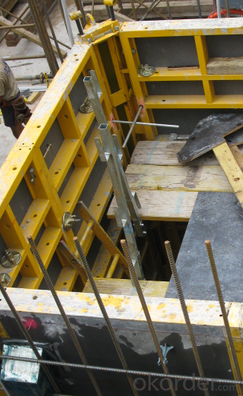
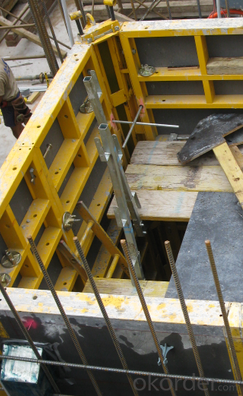
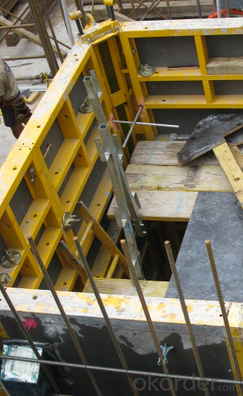
4. Single-side Steel Framed Formwork Specifications
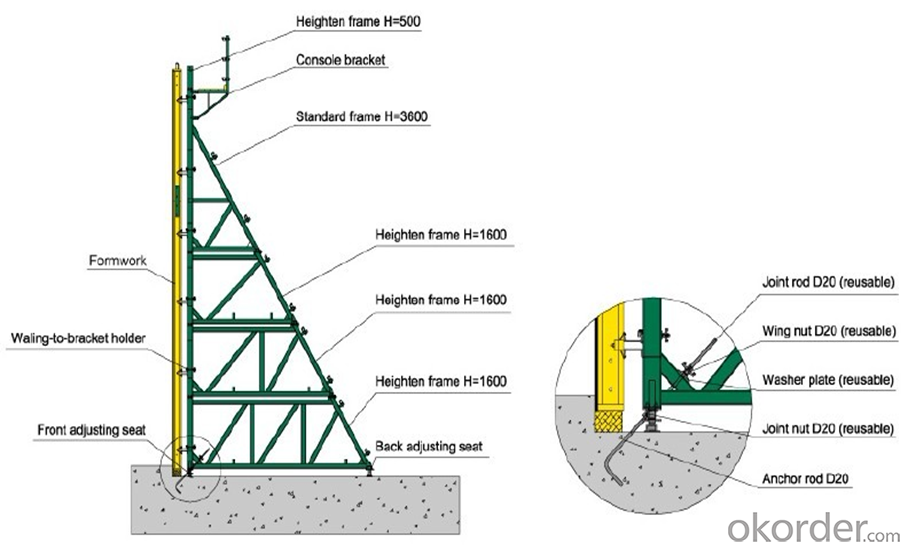
5.FAQ of 120 Steel Framed Formwork
1) What can we do for you?
.We can ensure the quality of the 120 steel framed formwork and avoid extra expenses for customers.
.We can provide you the professional technical team.
.We can provide professional building proposal for your project.
. Please feel free to customize.
2) What promises can be done by us?
. If interested in single side steel framed formwork, please feel free to write us for any QUOTE.
. If need any technical and building assistance, we could provide on-site professional staff for instruction.
. Please DO check goods when courier knocks your door and contact us asap if any issueS.
3) What about of our after-sale service?
. Response will be carried out in 24hours after receiving any complain or request.
. Single side steel framed formwork cost can be refund after order is confirmed.
. If the products are not based on the requirements, there will be the relevant compensations made for you.
4) What about the package and shipping time?
.Packing: wood package and
.Shipping: by sea
Shipping time: Normally small orders, it just1week business days to arrive your hand; When comes to the customs declaration, it may need 2 weeks.
- Q:Can steel frame formwork be used for both precast and cast-in-place concrete walls?
- Yes, steel frame formwork can be used for both precast and cast-in-place concrete walls. The versatility of steel frame formwork allows for its application in various construction methods, making it suitable for both precast concrete walls, which are manufactured off-site, and cast-in-place concrete walls, which are poured on-site.
- Q:How does steel frame formwork compare to fiberglass formwork?
- Both steel frame formwork and fiberglass formwork are popular choices for construction projects, but they differ in terms of material composition, durability, and cost. To begin with, steel frame formwork is composed of steel frames and plywood panels. This combination provides excellent strength and stability, making it suitable for heavy-duty applications. The steel frames are capable of withstanding heavy loads and provide exceptional support for concrete pouring. Moreover, the plywood panels can be used multiple times in various projects due to their high reusability. On the contrary, fiberglass formwork is constructed using reinforced fiberglass panels. This material is lightweight yet durable, which offers advantages in terms of easier handling and transportation. Additionally, the fiberglass panels display resistance to water, chemicals, and UV radiation, making them ideal for projects with specific requirements such as coastal areas or corrosive environments. In terms of durability, steel frame formwork is generally regarded as more resistant to wear and tear. Steel frames have a longer lifespan and can endure rough handling and extreme weather conditions. They are also less prone to deformation and can be easily repaired or modified if necessary. While fiberglass formwork is durable, it may be more susceptible to damage if mishandled or subjected to excessive force. However, both types of formwork can have extended lifespans with proper care and maintenance. Cost is another aspect to consider when comparing steel frame formwork to fiberglass formwork. Initially, steel frame formwork tends to be more expensive as it requires the purchase of steel frames and plywood panels. However, due to its high reusability, the overall cost per project may be lower in the long run. On the other hand, fiberglass formwork is cheaper upfront but may need to be replaced more frequently, resulting in higher overall costs over time. In conclusion, steel frame formwork and fiberglass formwork each have their own advantages and disadvantages. Steel frame formwork offers strength, stability, and durability, making it suitable for heavy-duty applications. On the other hand, fiberglass formwork is lightweight, resistant to environmental factors, and initially more cost-effective. Ultimately, the choice between the two will depend on the specific project requirements, budget constraints, and expected lifespan of the formwork.
- Q:What is steel wood formwork?
- 1, light weight, easy to carry, used in high-rise building walls and columns.2, the connection of the two templates, as long as the pin can be any combination, (as long as a tool hammer) greatly improved efficiency, saving labor.
- Q:Are there any specific requirements for the concrete mix used with steel frame formwork?
- Specific requirements exist for the concrete mix utilized in conjunction with steel frame formwork. To guarantee the structural integrity and strength of the construction, certain properties must be present in the concrete mix. To begin with, the concrete mix must possess a high compressive strength. This is imperative to withstand the pressure and weight exerted by the steel frame and other loads imposed on the structure. The exact compressive strength requirement will be contingent upon the design and intended purpose of the structure. Additionally, the concrete mix should exhibit favorable workability. It should be effortless to pour, compact, and mold within the steel frame formwork. This is crucial in achieving the desired shape and dimensions of the structure. The workability of the concrete can be enhanced by incorporating suitable admixtures, such as plasticizers or superplasticizers. Furthermore, the concrete mix should exhibit minimal tendencies for bleeding and segregation. Bleeding refers to the separation of water from the mix, while segregation refers to the separation of coarse aggregates from the mix. These issues can result in an uneven distribution of materials and compromise the overall strength and durability of the structure. Appropriate mix design and control can mitigate these problems. Lastly, the concrete mix should possess sufficient durability. It should possess resistance to environmental factors such as freeze-thaw cycles, chemical attacks, and abrasion. This is vital for the long-term performance and lifespan of the structure. The mix design should incorporate appropriate cementitious materials, aggregates, and admixtures to enhance the durability of the concrete. In conclusion, the concrete mix employed in conjunction with steel frame formwork necessitates high compressive strength, good workability, low bleeding and segregation tendencies, and adequate durability. These requirements guarantee the structural integrity and long-term performance of the construction.
- Q:How does steel frame formwork support vertical loads?
- Steel frame formwork supports vertical loads by providing a robust and rigid structure that can withstand the weight and pressure exerted on it. The steel frame is designed to distribute and transfer the vertical loads, such as the weight of the concrete, to the foundation or supporting structure below. The formwork system consists of steel panels, beams, and columns that are interconnected to create a sturdy frame. These elements are designed to be strong enough to resist the forces and deformations induced by the vertical loads. The vertical loads are transferred from the concrete slab or beam to the steel frame through the use of tie rods, braces, and connectors. These components ensure that the formwork system remains stable and can resist the pressure exerted by wet concrete during the pouring and curing process. The steel frame formwork also incorporates additional features like adjustable props and supports to provide further stability and flexibility. These props can be adjusted to accommodate variations in the formwork height and to counteract any uneven loads. Furthermore, the steel frame formwork is designed to be reusable, which allows for cost savings and a more sustainable construction process. The steel components can be easily dismantled, cleaned, and reassembled for use in other projects, making it a highly versatile and efficient solution for supporting vertical loads. In summary, steel frame formwork supports vertical loads by providing a robust and rigid structure that distributes and transfers the weight and pressure exerted by the concrete. With its strong and reusable components, the system ensures stability, durability, and cost-effectiveness in construction projects.
- Q:What are the different types of coatings available for steel frame formwork?
- There are several types of coatings available for steel frame formwork, each offering unique properties and advantages. These coatings are specifically designed to protect the steel frame formwork from corrosion, enhance its durability, and improve its overall performance. 1. Zinc Coating: Zinc coating, also known as galvanizing, is one of the most commonly used coatings for steel frame formwork. It provides excellent corrosion resistance by creating a protective layer on the steel surface. This coating is highly durable and can withstand harsh environments, making it suitable for both indoor and outdoor applications. 2. Epoxy Coating: Epoxy coatings are widely used for their high chemical resistance and durability. These coatings are applied in multiple layers, providing a strong protective barrier against corrosion, chemicals, and abrasion. Epoxy coatings also offer excellent adhesion to the steel surface, ensuring long-lasting protection. 3. Polyurethane Coating: Polyurethane coatings are known for their exceptional resistance to weathering and UV radiation. They provide a durable and flexible protective layer that can withstand extreme temperatures and mechanical stress. Polyurethane coatings also offer good chemical resistance and are often used in highly demanding environments. 4. Powder Coating: Powder coating is a popular choice for steel frame formwork due to its aesthetic appeal and excellent durability. It involves applying a dry powder to the steel surface and then heating it to form a protective coating. Powder coatings offer a wide range of colors and finishes, making them suitable for architectural purposes as well. 5. Paint Coating: Paint coatings are the most common and cost-effective option for steel frame formwork. These coatings come in various types, including acrylic, alkyd, and epoxy paints. While they may not offer the same level of corrosion resistance as other coatings, proper surface preparation and regular maintenance can ensure long-lasting protection. It is important to consider the specific requirements of the formwork project, such as the environment, exposure to chemicals or moisture, and aesthetic considerations, when choosing the appropriate coating for steel frame formwork. Consulting with a coating specialist or a professional engineer can help determine the most suitable coating type for specific applications.
- Q:What are the different types of stripping methods used with steel frame formwork?
- There are several different types of stripping methods used with steel frame formwork, including crane stripping, hydraulic stripping, and manual stripping. Crane stripping involves using a crane to lift and remove the formwork from the concrete structure. Hydraulic stripping utilizes hydraulic jacks to lift and separate the formwork from the concrete. Manual stripping involves manually dismantling and removing the formwork by hand. These methods offer varying degrees of speed, efficiency, and labor requirements depending on the specific project and requirements of the formwork system.
- Q:How does steel frame formwork handle the load distribution of a structure?
- Steel frame formwork handles the load distribution of a structure by providing a strong and rigid framework that supports the weight and forces exerted on the structure. The steel frames are designed to evenly distribute the loads from the concrete, ensuring that the structure remains stable and can withstand the various forces acting upon it, such as gravity, wind, and seismic forces. This load distribution capability of steel frame formwork helps in maintaining the structural integrity and safety of the overall construction.
- Q:How does steel frame formwork contribute to better concrete compaction?
- Steel frame formwork contributes to better concrete compaction by providing a rigid and stable structure that holds the concrete in place during the pouring and curing process. The steel frame formwork ensures that the concrete is properly contained, preventing any displacement or bulging that could occur with other types of formwork. This allows for a more even distribution of the concrete and ensures that it is compacted uniformly, resulting in a higher quality and more durable finished product.
- Q:What are the environmental certifications required for steel frame formwork?
- There are several environmental certifications required for steel frame formwork. One important certification is the Forest Stewardship Council (FSC) certification, which ensures that the wood used in the formwork is sourced from responsibly managed forests. This certification guarantees that the wood is harvested in an environmentally friendly and socially responsible manner. Additionally, the steel used in the frame formwork should be certified by organizations such as ISO 14001, which sets standards for environmental management systems. This certification ensures that the steel manufacturing process follows strict environmental guidelines, including waste management, energy efficiency, and reduction of greenhouse gas emissions. Another crucial certification is the LEED (Leadership in Energy and Environmental Design) certification. LEED is a globally recognized rating system for green buildings, and it evaluates the environmental performance of construction materials and processes. Steel frame formwork should meet the criteria set by LEED to be considered environmentally friendly. Furthermore, it is important for steel frame formwork to adhere to the ISO 9001 certification, which focuses on quality management systems. While not directly related to the environment, this certification ensures that the manufacturing process of the formwork is efficient, reliable, and promotes a high-quality end product. Overall, the environmental certifications required for steel frame formwork include FSC certification for wood sourcing, ISO 14001 for steel manufacturing, LEED certification for overall environmental performance, and ISO 9001 for quality management systems. These certifications demonstrate a commitment to sustainability and responsible construction practices.
1. Manufacturer Overview |
|
|---|---|
| Location | |
| Year Established | |
| Annual Output Value | |
| Main Markets | |
| Company Certifications | |
2. Manufacturer Certificates |
|
|---|---|
| a) Certification Name | |
| Range | |
| Reference | |
| Validity Period | |
3. Manufacturer Capability |
|
|---|---|
| a)Trade Capacity | |
| Nearest Port | |
| Export Percentage | |
| No.of Employees in Trade Department | |
| Language Spoken: | |
| b)Factory Information | |
| Factory Size: | |
| No. of Production Lines | |
| Contract Manufacturing | |
| Product Price Range | |
Send your message to us
STEEL FRAMED FORMWORK AND ITS ACCESSORIES FOR BUILDING CONSTRUCTION
- Loading Port:
- Shanghai
- Payment Terms:
- TT OR LC
- Min Order Qty:
- 1 m²
- Supply Capability:
- 100000 m²/month
OKorder Service Pledge
OKorder Financial Service
Similar products
New products
Hot products
Hot Searches
Related keywords



